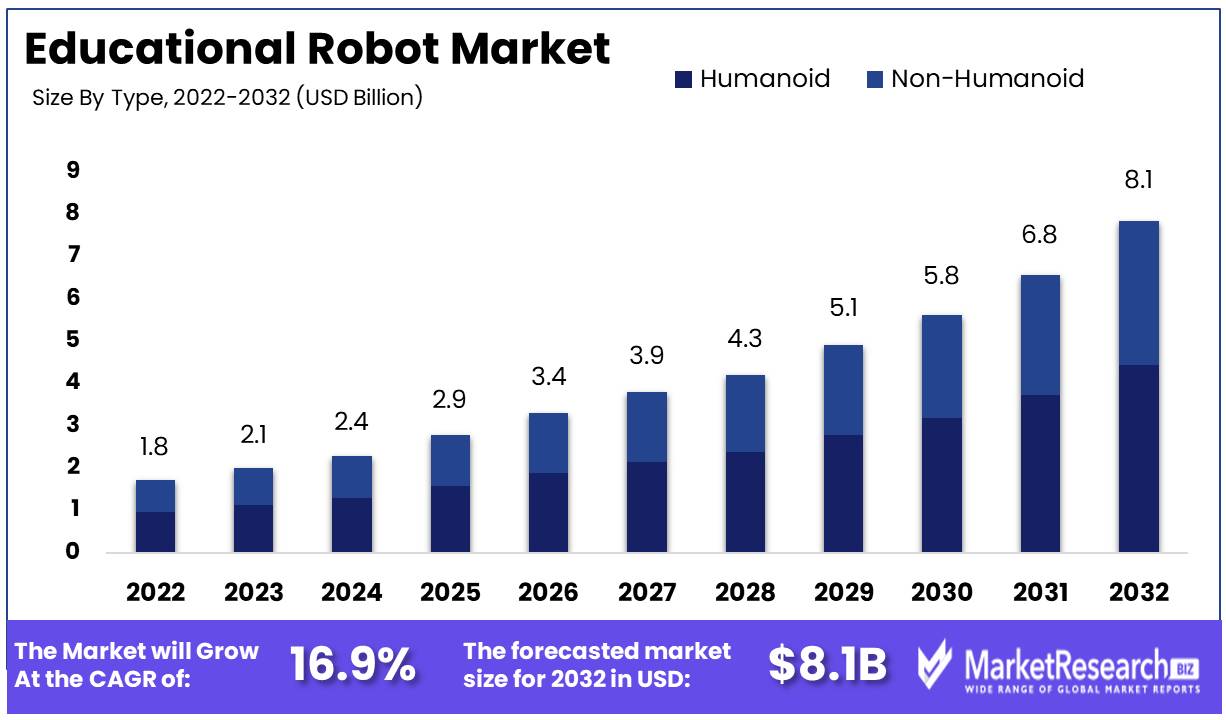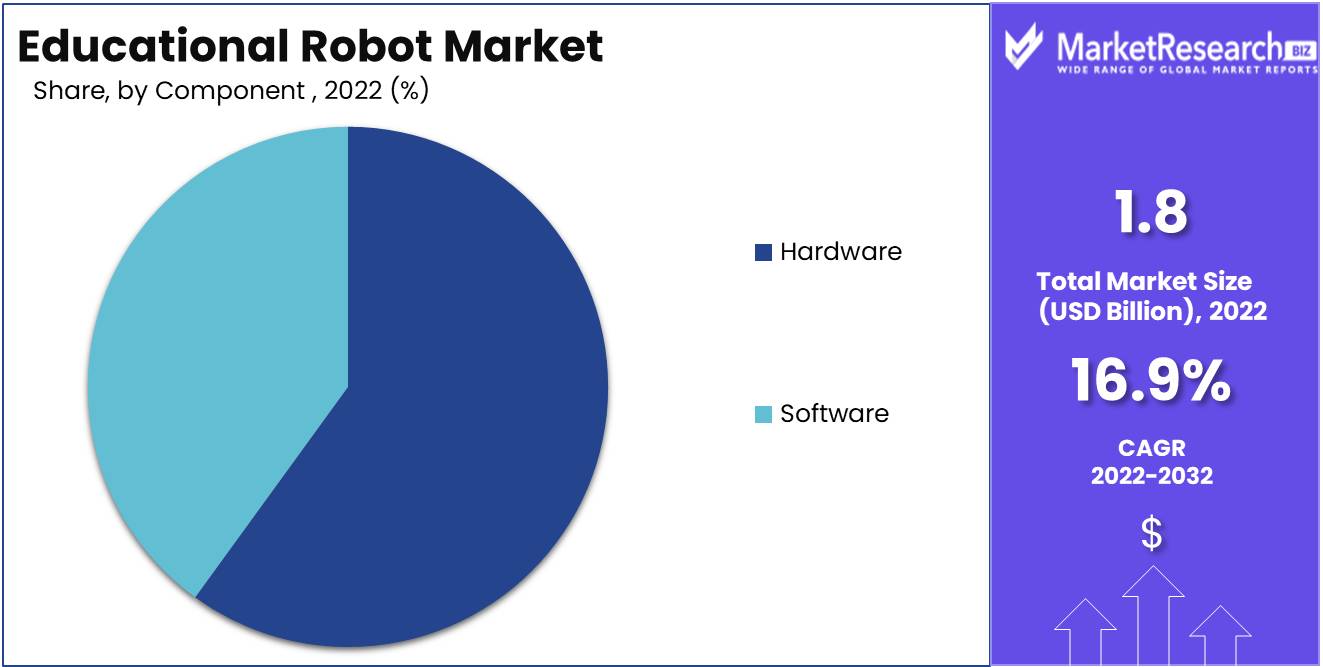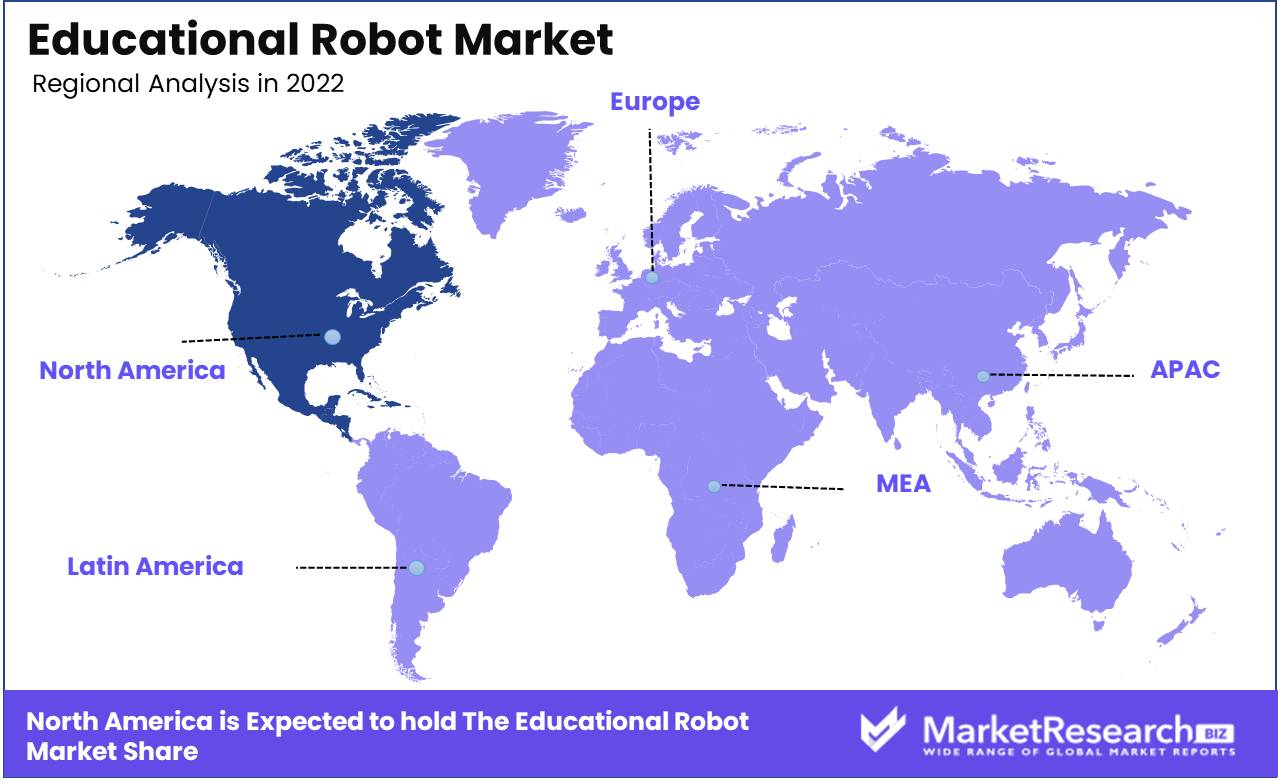
Educational Robot Market By Type (Humanoid, Non-Humanoid), By Component (Hardware, Software), By Application (Language Learning, STEM Education, Robotic Competitions, and Others), By Region And Companies - Industry Segment Outlook, Market Assessment, Competition Scenario, Trends, And Forecast 2023-2032
-
29758
-
May 2023
-
166
-
-
This report was compiled by Correspondence Linkedin | Detailed Market research Methodology Our methodology involves a mix of primary research, including interviews with leading mental health experts, and secondary research from reputable medical journals and databases. View Detailed Methodology Page
-
Report Overview
Educational Robot Market size is expected to be worth around USD 8.1 Bn by 2032 from USD 1.8 Bn in 2022, growing at a CAGR of 16.9% during the forecast period from 2023 to 2032.
The Educational Robot Market report provides a thorough analysis of the industry's current status and future prospects. It provides information regarding market size, growth rate, market share, and revenue. The report describes the leading market participants, their strategies, and their market positioning. In addition, it discusses the primary industry drivers, challenges, and opportunities.

The Educational Robot Market is a rapidly expanding industry that concentrates on the design and production of robots for educational purposes. These robots are designed to engage students in a manner that makes learning pleasant and engaging. Recent technological advancements have made educational robots more accessible and effective.
The primary purpose of educational robots is to improve the learning experiences of students. Through interactive activities, they hope to promote critical thinking, creativity, and abstract reasoning. Educational robots seek to improve the teaching process by providing teachers with invaluable tool for teaching STEM subjects.
Educational robots play a crucial position in the current educational environment. They provide students with the opportunity to engage in interactive and pleasurable learning, thereby boosting motivation and engagement. This procedure is more effective than conventional instructional methods. In addition, educational robots can be used to teach a variety of subjects, making them adaptable and valuable in a variety of contexts.
The field of educational robots is constantly evolving, with new innovations being introduced frequently. Notable developments include the application of artificial intelligence to personalize the learning experience, the incorporation of natural language processing to improve communication, and the development of sensors that can detect emotions and adapt to students' mental states.
In the future years, the market for educational robots is projected to expand significantly. This expansion is driven by rising demand from colleges, universities, and individual consumers. Moreover, technological advancements are facilitating and reducing the cost of manufacturing these robots, thereby contributing to the expansion of the market.
The rising demand for personalized and interactive learning experiences, the need for cost-effective and efficient teaching methods, and the growing awareness of the benefits of STEM education are the primary growth drivers for the educational robot market. The adoption of innovative technologies, such as artificial intelligence and natural language processing, also contributes to the expansion of the market.
Concerns have been expressed, however, about the effect on human-to-human interaction and the possibility of robots replacing teachers. Therefore, it is essential that the development of educational robotics prioritizes openness, explicability, and responsibility. Appropriate safeguards should be implemented to prevent misuse and protect privacy rights.
Driving factors
An Emphasis On STEM Education
The promotion of Science, Technology, Engineering, and Mathematics (STEM) education has received global attention. Educational Robot offers a hands-on approach to these subjects, allowing students to implement theoretical concepts in a practical and engaging manner. In order to improve STEM education, educational institutions, and governments are investing in educational machines.
The Increasing Focus On Personalized Learning
To meet the unique learning requirements of each student, educational robots can be customized and programmed. They are capable of providing personalized feedback, adapting to various learning techniques, and providing individualized educational content. Educational robots have become beneficial tools in classrooms and other learning environments due to the increasing significance of personalized learning.
Growing Awareness Of The Importance Of Coding And Robotics Skills
Coding and robotics expertise are becoming increasingly acknowledged as essential for future job prospects. Students can learn and practice coding and robotics concepts through the use of educational robots. As more industries adopt automation and robotics, it is anticipated that the demand for coding and robotics skills will increase, propelling the adoption of educational robots.
Supportive Government Initiatives
Globally, governments are implementing initiatives to promote the incorporation of technology in education. They are investing in educational robotics programs, funding schools and educational institutions, and devising policies to facilitate the adoption of educational robots. These initiatives foster an environment conducive to the expansion of the educational robot market.
Benefits of Experiential and Interactive Learning
Students can engage in problem-solving, critical thinking, and collaborative activities thanks to the experiential and interactive learning experiences provided by educational robots. These practical exercises increase student engagement, motivation, and retention of knowledge. Consequently, educational institutions are recognizing the importance of educational robots in nurturing effective learning environments.
Restraining Factors
The High Initial Investment Cost
The high initial investment cost is one of the primary factors restraining the educational robot market. The purchase price of educational robotics can pose a significant challenge for schools with limited budgets. However, the long-term advantages of educational robots significantly outweigh their long-term costs. Educational robots can provide teachers and pupils with cost-effective classroom solutions. Using the most recent technological advancements, educational robots can create immersive learning environments that can supplement classroom instruction, reduce teacher workload, and improve student outcomes.
Concerns over Data Privacy and Security are raised
Concerns about data privacy and security are also restraints on the educational robot market. The vast quantity of sensitive data collected by educational robots must be protected from unauthorized access and manipulation. It is crucial to ensure that the collected data is safe from cyberattacks and that student privacy is respected. Strong passwords, firewalls, and routine data backups should be adopted as best practices for data privacy and security in schools. This will assist in addressing the concerns and reassuring parents and guardians about their children's protection.
Limited Availability of Skilled Personnel
Another challenge in the educational robot market is the limited availability of qualified personnel. Personnel with the ability to design, construct, program, and maintain educational robots are in limited supply, which can hinder their adoption and operation. To address this issue, schools should create an educational environment that encourages students to pursue careers in STEM (science, technology, engineering, and mathematics) disciplines, which will inevitably increase the future pool of skilled workers.
Few Limited Customization Options
Customization options are also a barrier to educational robots' widespread adoption. As the educational robot market continues to develop, customization options are crucial, allowing schools to tailor educational robots to their particular requirements. Many educational robots are designed with predetermined programs that may not correlate with the institution's or class's specific learning objectives. Therefore, it is necessary to design educational robots that are adaptable, flexible, and easily modifiable to meet specific learning objectives.
Type Analysis
The Humanoid Robots segment dominates the Educational Robot Market, with new and innovative products being introduced each year. The humanoid robotics segment has the largest market share compared to all other segments in this market. The human-like appearance and behavior of humanoid robots are one of the primary reasons for their educational success. These robots can communicate, comprehend speech, and even demonstrate emotions, making them an ideal educational aid for children. The segment of humanoid robots includes NAO, Pepper, ASIMO, and Roboy, all of which are experiencing substantial year-over-year demand growth.
The expansion of the market for educational robots is not limited to developed nations. In the future years, the adoption of educational robots is anticipated to be driven by emerging economies such as China, India, and Brazil. The governments of these nations are making substantial investments in their education systems to ensure that their populations are prepared for the future. This expenditure includes the implementation of robotic technology in the classroom.
Many schools in emergent economies supplement traditional teaching methods with educational robots. This has increased the demand for products that meet the specific requirements of these markets. It is anticipated that the adoption of educational robotics will have a significant impact on economic growth and development in these nations.
Component Analysis
The Educational Robot Market is dominated by the Hardware Segment, The success of educational robots is primarily determined by their constituent parts. Hardware, which includes sensors, actuators, and other electronic components, dominates the global market for educational robots. The hardware segment is essential to the creation of educational robots because it enables them to execute tasks and interact with their surroundings. Robots are able to move, perceive their surroundings, and communicate with human participants or other robots due to their sophisticated sensors and motors.
The hardware segment of the educational robot market is expanding rapidly, primarily due to the economic expansion of developing nations. These nations are making substantial investments in technological infrastructure, including the creation of advanced robots. This investment is essential for these economies because it enables them to contend globally.
Due to a number of factors, the hardware segment of the educational robot market is anticipated to have the highest growth rate in the future years. Initially, the expanding emphasis on STEM education has increased the demand for robotics in schools and other educational settings. Hardware plays a crucial role in the advancement of robotics, making it an essential component of the educational landscape.

Application Analysis
The Language Learning Segment Rules the Educational Robot Market, The use of educational robots in the classroom is expanding significantly, and each year, new and innovative products are introduced. The purpose of these robots is to help children acquire a new language in an interactive and engaging manner. The language learning segment consists of products such as My Pal Scout, Ezybot, and LingoBot, all of which offer a novel and efficient method for learning a new language. These robots are excellent instruments for educators, as they facilitate the creation of personalized learning experiences for students.
Due to the rising demand for multilingual education, the segment of language acquisition is experiencing rapid expansion globally. To provide their citizens with a global language advantage, emerging economies are investing heavily in their education systems, and educational robots are an excellent method to do so.
Due to a number of factors, the language learning segment of the educational robot market is anticipated to have the highest growth rate. First, the global demand for multilingual education is increasing rapidly. Educational robots provide an innovative and efficient method to meet this demand, making them indispensable to the educational landscape.
Key Market Segments
By Type
- Humanoid
- Non-Humanoid
By Component
- Hardware
- Software
By Application
- Language Learning
- STEM Education
- Programming and Coding Education
- Special Education
- Social and Emotional Learning(SEL)
- Robotic Competitions
- Entertainment and Edutainment
Growth Opportunity
Increasing demand for educational robots in emerging markets
Globally, emerging markets are experiencing rapid growth and development. With this expansion comes a corresponding increase in demand for education and advanced technology. Educational robots provide pupils in emerging markets with access to educational tools and resources to which they might not otherwise have had access. In addition, educational robots can assist instructors in underserved regions where there may be a dearth of qualified educators. As more students around the globe gain access to educational robots, it is anticipated that the market for these robots will continue to expand.
Growing focus on personalized learning experiences
An important advantage of educational robots is that they enable a more individualized learning experience. The robot allows students to work at their own tempo and provides them with individualized instruction. This individualized approach ensures that students can completely comprehend the concepts they are learning and can advance at their own pace. Demand for educational robots is likely to increase as more institutions prioritize personalized learning environments.
Integration of robots in virtual and online learning environments
With the emergence of virtual and online learning environments, the significance of educational robots is growing. Even if they are not physically present in the classroom, these devices can provide students with a more engaging and interactive learning environment. In addition, educational robots can assist teachers in virtual environments by automating specific duties and providing students with additional resources. As the trend toward virtual and online learning persists, it is anticipated that the demand for educational robots will rise.
Advancements in robotics technology and artificial intelligence
Educational robots are more sophisticated and capable than ever before thanks to advancements in robotics technology and artificial intelligence. These robots can now perform a variety of duties and activities, from assisting students with their homework to providing them with hands-on science and engineering experience. As robotics technology and artificial intelligence continue to advance, it is likely that the educational robot market will expand.
Rising demand for educational robots in non-traditional learning environments
The demand for educational robots in non-traditional learning environments is increasing as education becomes more adaptable and less regimented. These automata can be utilized in a variety of contexts, from after-school programs to museum displays. They can offer students additional learning opportunities beyond the traditional classroom setting. As the number of non-traditional learning environments continues to rise, the demand for educational robots will also increase.
Latest Trends
Adoption of Collaborative Robots in Education
The increasing adoption of collaborative robots in education is one of the most significant market trends affecting the Educational Robot Market. Collaborative robots provide an efficient method for teaching students about robotics and programming, as well as an interactive and engaging platform for learning essential STEM subjects. Teachers can provide students with hands-on experience in robotics, programming, and critical thinking by incorporating collaborative robots into the classroom, leading to improved learning outcomes.
Development of Open Source Robotics Platforms
The development of open-source robotics platforms is a significant trend that is reshaping the Educational Robot Market. Open-source robotics platforms enable users to personalize and modify the robot's hardware and software, allowing them to construct robots tailored to their specific requirements. These platforms encourage creativity and problem-solving skills by encouraging innovation and allowing users to experiment with various features and functions.
Use of Robots for Special Education
A significant trend in the Educational Robot Market is the use of robots for special education. Children with special needs can be provided with a secure and comfortable environment by robots, which promotes their social and emotional development. They provide therapeutic benefits and can assist children in overcoming communication barriers, thereby facilitating their integration into the learning process.
The Emergence of Social Robots for Language Learning
A further significant trend in the Educational Robot Market is the emergence of social robots for language acquisition. Social robotics can provide an entertaining and interactive method for learning languages, thereby making the process more engaging and memorable. They provide individualized language tutoring by adapting the curriculum to the student's requirements and skills, resulting in improved learning outcomes.
Integration of Robots with Augmented Reality and Virtual Reality
The integration of robots with augmented reality and virtual reality transforms the Educational Robot Market. Realistic and immersive interactions between robots and students are made possible by these technologies. The combination of robots, augmented reality, and virtual reality can provide a more comprehensive learning environment, allowing students to investigate complex subjects in a fun and engaging manner.
Regional Analysis
The dominance of the North American region in the education robot market can be attributed, in part, to the prevalence of major players in the region. Pepper has been adopted by numerous educational institutions in the North American region, allowing students to interact with technology and learn more about robotics. In addition, numerous institutions in North America have invested in RobotLAB's robots, which are designed to improve students' STEM (Science, Technology, Engineering, and Mathematics) knowledge.
The increasing adoption of advanced technologies in education is another factor that contributes to North America's dominance in the education robot market. This has enabled students to learn in a novel and interactive manner. In education, robots are used to teach subjects such as mathematics, language, and science, thereby expanding students' knowledge beyond the traditional classroom. The increased student engagement that has resulted from robots' interactive and individualized approach to instruction has contributed to an improved overall learning experience.
While the dominance of the North American region in the education robot market can be attributed to the presence of major players and the rising adoption of advanced technology in education, it is distinguished from other regions by a number of factors. One such factor is the region's entrepreneurial character, which drives innovation and advancement in robotics. North American educational institutions, startups, and established corporations collaborate to expand the boundaries of educational robotics.

Key Regions and Countries
North America
- US
- Canada
- Mexico
Western Europe
- Germany
- France
- The UK
- Spain
- Italy
- Portugal
- Ireland
- Austria
- Switzerland
- Benelux
- Nordic
- Rest of Western Europe
Eastern Europe
- Russia
- Poland
- The Czech Republic
- Greece
- Rest of Eastern Europe
APAC
- China
- Japan
- South Korea
- India
- Australia & New Zealand
- Indonesia
- Malaysia
- Philippines
- Singapore
- Thailand
- Vietnam
- Rest of APAC
Latin America
- Brazil
- Colombia
- Chile
- Argentina
- Costa Rica
- Rest of Latin America
Middle East & Africa
- Algeria
- Egypt
- Israel
- Kuwait
- Nigeria
- Saudi Arabia
- South Africa
- Turkey
- United Arab Emirates
- Rest of MEA
Key Players Analysis
The Educational Robot Market is expanding swiftly, with both new entrants and established companies releasing new and innovative robots. Each of the leading companies in this industry strives to provide the finest product for the education market.
LEGO Education is one of the foremost competitors in the Educational Robot Market. They offer a variety of robotics kits designed for pupils from elementary school through high school. These kits are extremely interactive and facilitate the development of student's critical thinking, problem-solving, and teamwork skills.
Wonder Workshop, which produces the Dash and Dot robots, is also a significant player in this industry. These robots are intended for the K-5 education market and provide pupils with a fun and engaging way to learn coding and robotics.
Another prominent company in the Educational Robot Market is Sphero. They offer a variety of programmable robots, including the renowned Star Wars BB-8 droid. These robots encourage students' inventive thinking and problem-solving.
Robo Wunderkind is new to the Educational Robot Market. They provide modular robotics packages that enable students to construct and program robots. This strategy promotes student creativity and project-based learning.
Top Key Players in Educational Robot Market
- Aisoy Robotics
- Hanson Robotics Limited
- Modular Robotics
- PAL Robotics
- Probotics America
- Sanbot Innovation Technology. Ltd
- Life & Science, Inc.
- Robotis Co. Ltd.
- SoftBank Robotics Group Corp.
- Lego System A/S.
- Other Market Players
Recent Development
- In 2021, the Educational Robot Market will undergo a revolution as a result of several innovative developments. SoftBank Robotics' launch of Whiz, an autonomous vacuum cleaner designed specifically for public spaces such as schools and offices, is one of the most significant developments. In light of the ongoing pandemic, Whiz is not only a time-saving solution for cleaning personnel, but it also promotes a safer and more hygienic environment.
- In 2020, UBTECH Robotics released a new iteration of its Jimu Robot BuilderBots Kit. The kit contains robotics that can be programmed and controlled via a mobile application. This innovation offers an effective and interactive approach to robotics, programming, and STEM education that is tailored to students.
Report Scope
Report Features Description Market Value (2022) USD 1.8 Bn Forecast Revenue (2032) USD 8.1 Bn CAGR (2023-2032) 16.9% Base Year for Estimation 2022 Historic Period 2016-2022 Forecast Period 2023-2032 Report Coverage Revenue Forecast, Market Dynamics, COVID-19 Impact, Competitive Landscape, Recent Developments Segments Covered By Type (Humanoid, Non-Humanoid)
By Component (Hardware, Software)
By Application (Language Learning, STEM Education, Programming and Coding Education, Special Education, Social and Emotional Learning(SEL), Robotic Competitions, Entertainment and Edutainment)Regional Analysis North America – The US, Canada, & Mexico; Western Europe – Germany, France, The UK, Spain, Italy, Portugal, Ireland, Austria, Switzerland, Benelux, Nordic, & Rest of Western Europe; Eastern Europe – Russia, Poland, The Czech Republic, Greece, & Rest of Eastern Europe; APAC – China, Japan, South Korea, India, Australia & New Zealand, Indonesia, Malaysia, Philippines, Singapore, Thailand, Vietnam, & Rest of APAC; Latin America – Brazil, Colombia, Chile, Argentina, Costa Rica, & Rest of Latin America; Middle East & Africa – Algeria, Egypt, Israel, Kuwait, Nigeria, Saudi Arabia, South Africa, Turkey, United Arab Emirates, & Rest of MEA Competitive Landscape Aisoy Robotics, Hanson Robotics Limited, Modular Robotics, PAL Robotics, Probotics America, Sanbot Innovation Technology. Ltd, Life & Science Inc., Robotis Co. Ltd., SoftBank Robotics Group Corp., Lego System A/S. Customization Scope Customization for segments, region/country-level will be provided. Moreover, additional customization can be done based on the requirements. Purchase Options We have three licenses to opt for Single User License, Multi-User License (Up to 5 Users), Corporate Use License (Unlimited User and Printable PDF) -
-
- Aisoy Robotics
- Hanson Robotics Limited
- Modular Robotics
- PAL Robotics
- Probotics America
- Sanbot Innovation Technology., Ltd
- Life & Science, Inc.
- Robotis Co., Ltd.
- SoftBank Robotics Group Corp.
- Lego System A/S.
- Other Market Players




